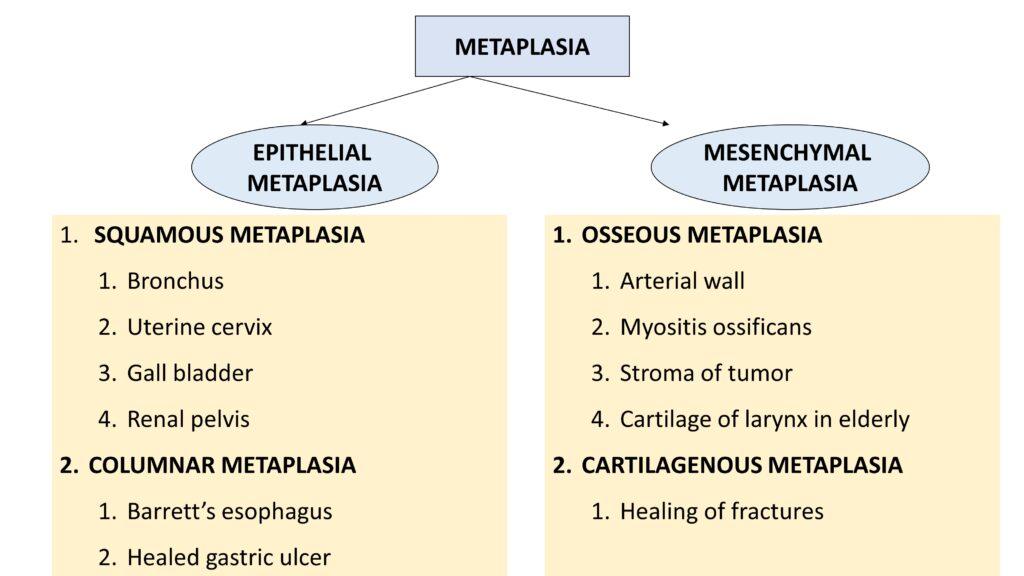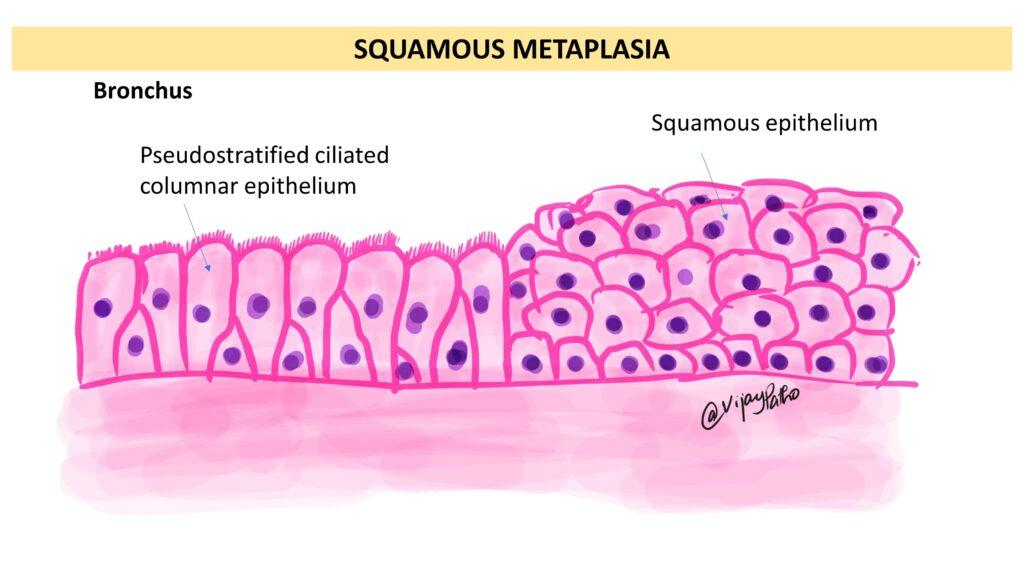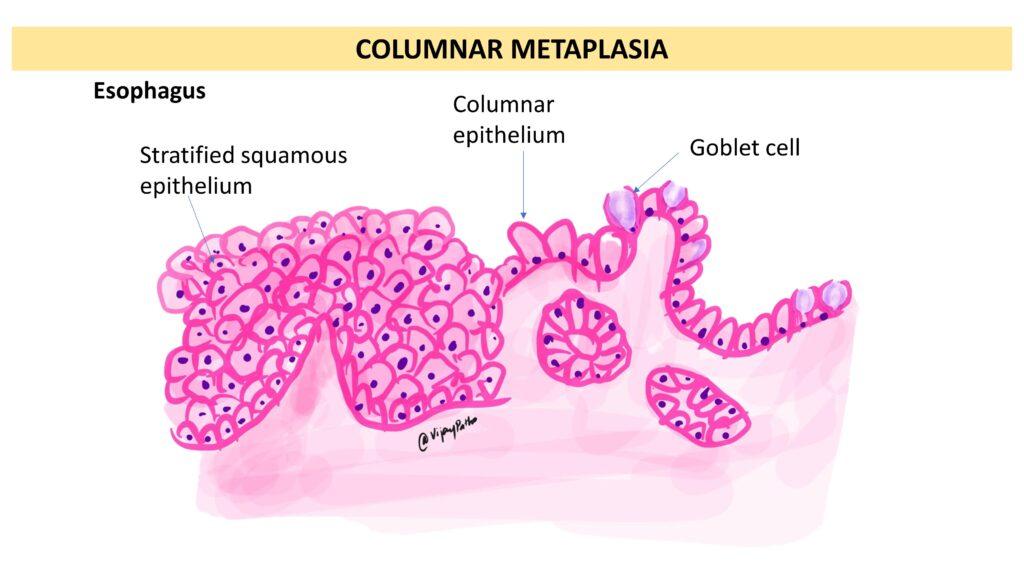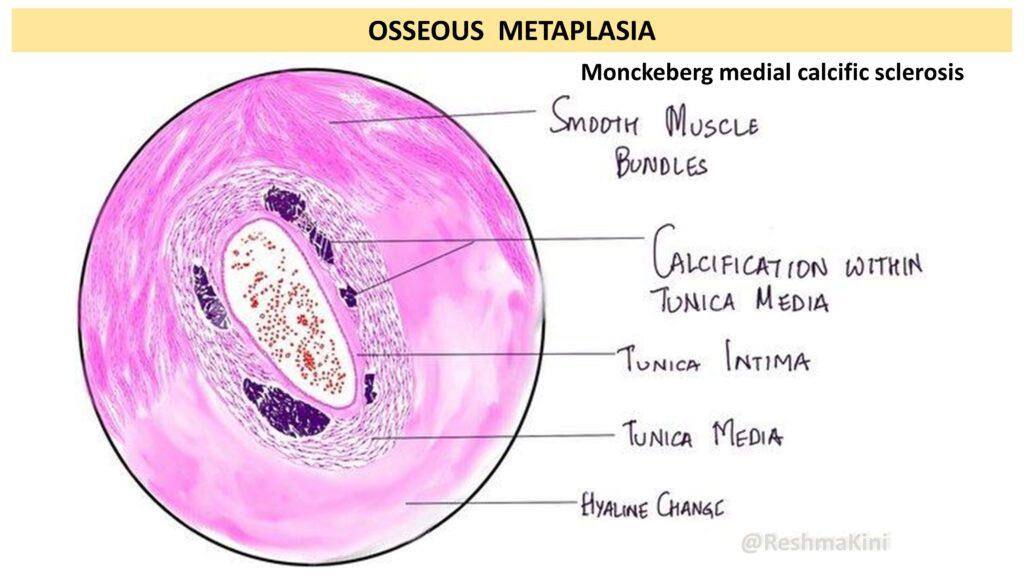What is metaplasia?
Metaplasia is a reversible cellular adaptation in which one differentiated cell type (epithelial or mesenchymal) is replaced by another cell type. This change occurs in response to chronic inflammation or irritation and represents a survival mechanism to withstand adverse conditions.
What causes metaplasia?
Metaplasia arises from reprogramming of stem cells present in normal tissues. This reprogramming is a complex process involving changes in gene expression patterns that prompt stem cells to differentiate into a cell type different from what is typically found in that location. This process is generally induced by chronic irritation or inflammation, and the new cell type is usually better suited to withstand the adverse environment, which is why metaplasia is considered an adaptive process.
What are the types of metaplasia
Epithelial Metaplasia: It is a switch between different types of epithelial cells. A common example is squamous metaplasia in the bronchial epithelium of smokers, where the normal columnar ciliated epithelial cells are replaced by squamous cells, which are more resistant to smoke irritation.
Mesenchymal Metaplasia: This type involves changes between different types of connective tissue cells. For example, myositis ossificans is a condition where muscle tissue transforms into bone following repeated trauma or injury.

Elaborate on epithelial metaplasia with examples
Epithelial metaplasia is a type of tissue adaptation in which one type of epithelial cell transforms into another type, typically in response to chronic irritation or inflammation.
There are two types of epithelial metaplasia :Squamous metaplasia and columnar metaplasia.
Squamous Metaplasia:
Bronchus: Chronic irritants like cigarette smoke can induce a change in the bronchial epithelium, transforming the normal columnar ciliated cells into squamous cells. This squamous epithelium is more resistant to smoke but loses its ability to clear mucus, potentially leading to respiratory problems

Uterine Cervix: The transformation of the glandular epithelium to a squamous type in the cervix can occur due to physical or chemical irritation, infections, or hormonal changes.
Gall Bladder: Squamous metaplasia in the gall bladder is typically associated with chronic cholecystitis. Stones or chronic infection can lead to this change.
Renal Pelvis: Similar to other areas, chronic irritation, often by kidney stones, can lead to squamous metaplasia of the renal pelvis.
Columnar Metaplasia:
Barrett’s Esophagus: This condition is a classic example where the normal squamous lining of the esophagus is replaced by a columnar epithelium due to chronic acid reflux from the stomach. Patients with Barrett’s esophagus are at an increased risk for esophageal adenocarcinoma, thus requiring regular follow up.

Healed Gastric Ulcer: In the context of a healing gastric ulcer, the regenerative process may sometimes involve the replacement of normal gastric epithelium with intestinal-type columnar epithelium, which is characterized by the presence of goblet cells. This type of metaplasia is a response to the inflammatory healing process.
Elaborate on mesenchymal metaplasia with examples
Mesenchymal metaplasia is a form of cellular adaptation where cells of connective tissue origin differentiate into a different type of mesenchymal cell.
There are two types of mesenchymal metaplasia :osseous metaplasia and cartilaginous metaplasia.
Osseous Metaplasia:
Arterial Wall: Monckeberg’s medial sclerosis, also known as medial calcific sclerosis or Monckeberg’s arteriosclerosis, specifically refers to the calcification of the tunica media, of muscular arteries. The smooth muscle cells in the tunica media undergo a transformation into osteoblast-like cells, which lay down a matrix that can become calcified, thus resembling bone.It is usually associated with aging and diabetes or even chronic kidney diseases.
Monckebergs medial sclerosis is of not much significance because they dont cause luminal narrowing unlike clacification in atherosclerosis which can cause obstruction.

Myositis Ossificans: In this condition, following muscle injury or inflammation, muscle tissue begins to transform into bone in an abnormal location. This often occurs as a response to severe or repeated trauma and can lead to significant functional impairment due to the stiffness and also pain which is associated with the ectopic bone formation.
Stroma of Tumor: Osseous metaplasia can occur within the stroma, or supportive tissue, of a tumor.
Cartilage of Larynx in Elderly: As individuals age, the cartilage within the larynx can sometimes undergo ossification. This is a normal part of aging where the cartilage cells transform into bone cells, potentially affecting the flexibility and function of the laryngeal structures.
Cartilaginous Metaplasia:
Healing of Fractures: When a bone fractures, the healing process involves the formation of a cartilaginous callus as a temporary bridge between the broken bone ends. This is a part of normal fracture healing, where mesenchymal stem cells differentiate into chondrocytes to produce cartilage, which is later replaced by bone in the process what is called as endochondral ossification.
click here to watch the video tutorial on Met
aplasia










Recent Comments